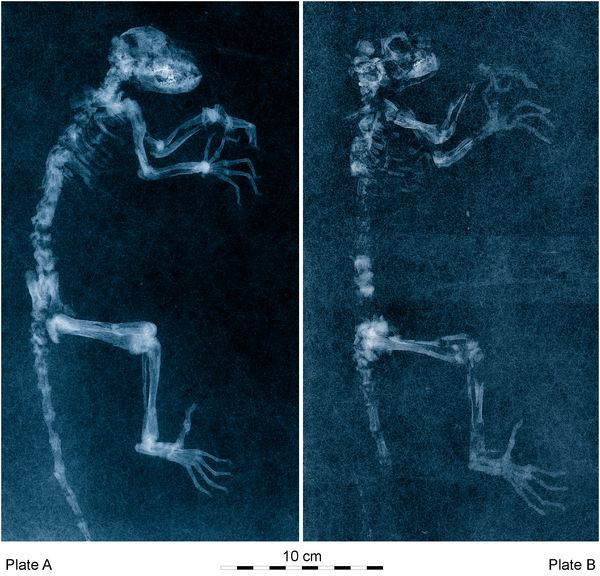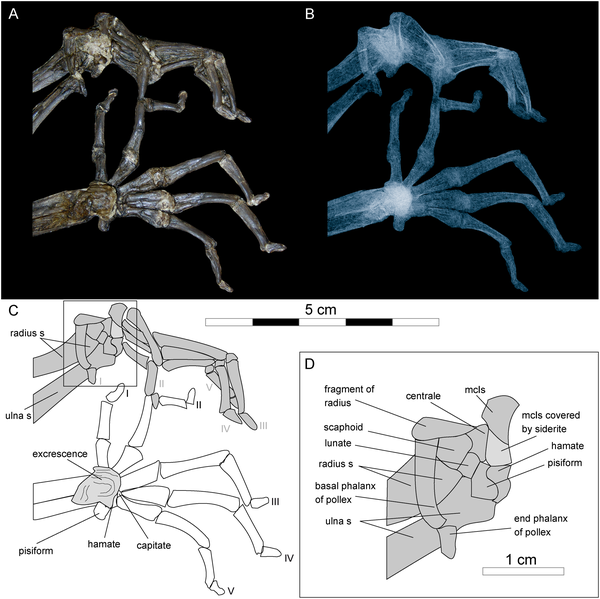The discovery was made at Grube Messel, near Darmstadt, Germany, where primates are rare and only fragmentary specimens had been located before. Because it was collected privately and sold in two parts, it is only now that its significance is known. It's phylogenetically intriguing because of the the absence of a toilet claw and a toothcomb. Darwinius masillae does have what are described as human-like nails and opposable big toes, which, if this turns out to be a 'stem group' from which anthropoid primates evolved, would place this fossil near the beginning of human evolution. Darwinius masillae is not simply a lemur fossil but instead part of Adapoidea, a larger group of primates - evidence of the early haplorhine diversification. In layman terms, this was a lemur-monkey, with features of both groups.
Darwinius masillae was a female that probably died in her first year of life.

Radiographs of Darwinius masillae. Relative positions and museum numbers as in Figure 1. Radiographs show that all of plate A is genuine, while cranium, thorax, upper arms (part 1), and lumbus, pelvis, base of tail, and upper legs (part 2) of plate B are genuine. From Franzen JL, Gingerich PD, Habersetzer J, Hurum JH, von Koenigswald W, et al. (2009) Complete Primate Skeleton from the Middle Eocene of Messel in Germany: Morphology and Paleobiology. PLoS ONE 4(5): e5723. doi:10.1371/journal.pone.0005723
So is this a Rosetta Stone of evolutionary biology? It will certainly be hyped a lot more than that but it may be warranted. It's difficult to imagine studies of Eocene-Oligocene primates that won't reference this discovery.
Basically it is a lemur monkey that is 'incomplete' but very close - a true transitional fossil. Biologists hate the term 'missing link' because it isn't very scientific but this is a case where it may be apt. It's hard to imagine that a female monkey under 2 feet tall discovered 25 years ago could accomplish all that, but after two years of study, the researchers are confident in their results.
Modern primates began to appear about 55 million years ago, at the beginning of the Eocene epoch, in two superfamilies, Arsioidea and Adapoidea. Though rare in Messel, the maar lake deposit turned out to be an ideal location because it was a paratropical Eocene rain forest.
From what can be determined, the fossil was discovered in 1983 and part of it basically hung on a collector's wall for nearly 20 years while another part was purchased by the Wyoming Dinosaur Center in 1991. In 2007 they were reconciled and work began using X-radiography and microcomputerized tomography.

Hands and wrist of Darwinius masillae. Photograph (A) and X-ray image (B) show the specimen preserved on plate A (Fig. 1). (C)— explanatory drawing, where I–V represent digits one to five. (D)— Inset interpretive drawing of the left wrist (box in C). From: Franzen JL, Gingerich PD, Habersetzer J, Hurum JH, von Koenigswald W, et al. (2009) Complete Primate Skeleton from the Middle Eocene of Messel in Germany: Morphology and Paleobiology. PLoS ONE 4(5): e5723. doi:10.1371/journal.pone.0005723
After so much work, you can imagine they have a great deal of excitement and a connection; they call her Ida.
Fortunately, discoveries like this have found attention in the right places. German authorities had plans to turn Messel into a garbage dump. Now it is instead off-limits to all but Senckenberg Museum scientists, which brings its own level of concern from other researchers. So enjoy some new possibilities, but until this gets a few years of outside study, take it with a grain of salt.
Citation: Franzen JL, Gingerich PD, Habersetzer J, Hurum JH, von Koenigswald W, et al. (2009) Complete Primate Skeleton from the Middle Eocene of Messel in Germany: Morphology and Paleobiology. PLoS ONE 4(5): e5723. doi:10.1371/journal.pone.0005723





Comments